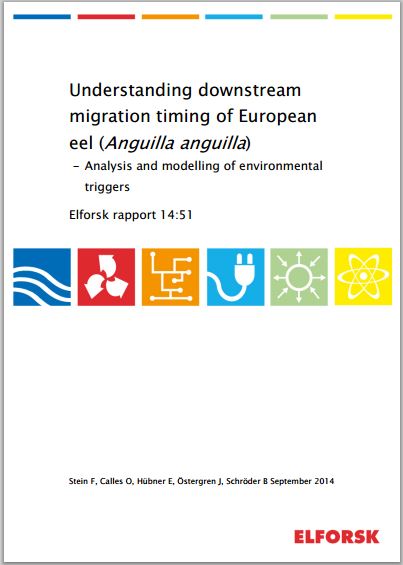REPORT: Downstream migration timing of Eel
Posted by olle.calles@gmail.com | Projekt Ål i Ätran, Projekt Krafttag Ål The report – Understanding downstream migration timing of European eel (Anguilla anguilla) – is finally available to DOWNLOAD.
The report – Understanding downstream migration timing of European eel (Anguilla anguilla) – is finally available to DOWNLOAD.
Summary: The European eel stock has long been in decline. Consequently, the species has been added to the IUCN Red List of Threatened Species. One threat that has been identified as one possibly having an impact on the stock is mortality caused by hydroelectric power plant turbines. Turbine management, which is adapted to preferable migration conditions, might reduce the risk of this threat. Our study, conducted at five locations in southern Sweden, aimed at learning about the migratory behaviour of European silver eels paying special attention to preferable environmental conditions for migration by using advanced statistical modelling.
Results indicated that downstream migration triggers can be reliably described using hydrological variables (discharge, precipitation or one of their dynamic derivations), water temperature and moon. Spring and autumn migrations seemed to be triggered differently. In spring, rising water temperatures seemed to be the key trigger, quite independently of hydrological variables and the moon. In the autumn, the importance of the moon and hydrological variables on downstream migration increased. In addition, migration triggers differed depending upon the size of the body of water and/or its location in the river system. In smaller/upstream tributaries, hydrological variables seemed to be the key trigger. In larger/downstream waters, the importance of water temperature and the moon increased.
The transferability of models was limited. Moreover, models indicated that in some cases, the dynamics of water temperature and hydrological variables (precipitation, discharge) provided more explanatory power than the measured, absolute values. Transferability among time series from the same location delivered some reliable results. Success of transferability between locations was limited to sites which originated from the same river catchment. In spring, migration activity did not occur until water temperatures exceeded 6.5 °C in a tributary and 9 °C in the Kävlingeån River. Eels showed significant nocturnal migration behaviour (98.5 %; n = 205) and migration activity became very unlikely in autumn if water temperatures dropped below 5 °C.
Our data on spring migration is limited to one site in a tributary and one site in a lower mainstream. Furthermore, spatial transferability among catchments has not been tested in previous studies. Therefore, we recommend that future studies be performed during the spring and autumn migrations in tributaries as well as lower mainstreams.
Moreover, previous studies indicate that some eels hesitate for several days or even reverse upstream instead of entering the traps the same night that they arrive. Additional visual techniques such as hydroacoustic cameras should be applied upstream of catch facilities in order monitor eel migration activity of unharmed eels. This enables the validation of trap catchability and consequently the response of our models.
Our results clearly show that turbine induced mortality could be minimized if turbine operation focuses on daytime periods, when water temperature is below 5 ° C and when the discharge not is stable or decreasing. Moreover, local adaptive turbine management should be accompanied by studies to determine the local constellation of environmental triggers. In addition, it will be crucial, that later applications (e.g. turbine management, early warning systems etc.) consider the temporal dynamic of water temperature and hydrological variables.


